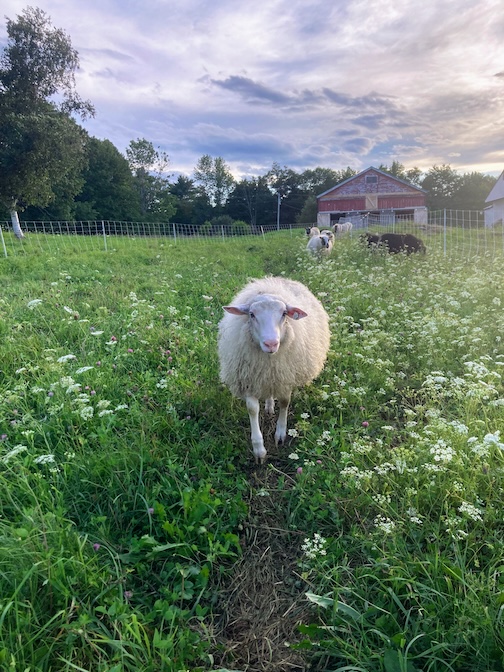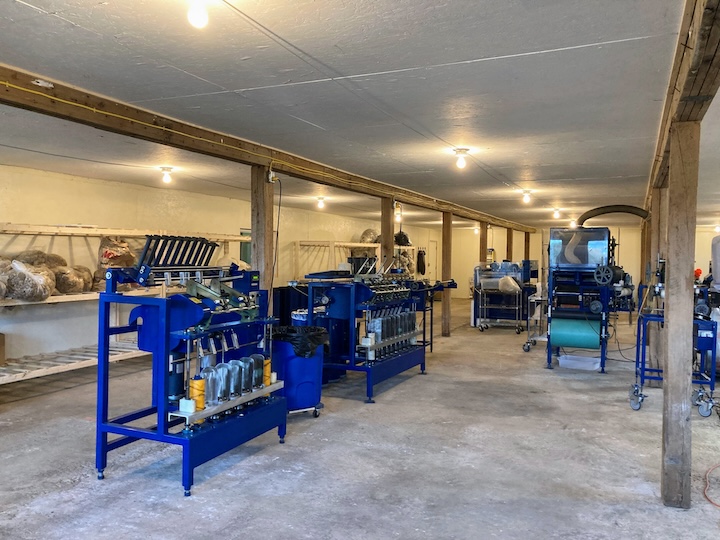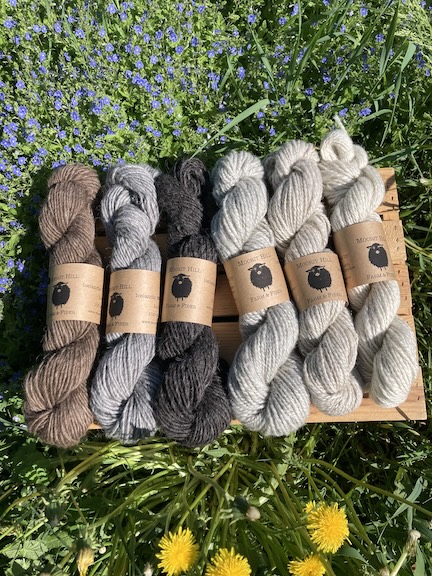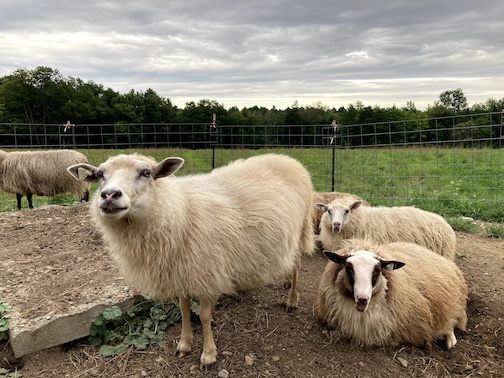By Sonja Heyck-Merlin
Moorit Hill Farm’s fiber mill does not invoke the action of a hand spinner, using the treadle to turn the wheel, creating the spinning action the hands need to coax fiber into yarn. Nor is it like the industrial fiber mills of yesteryear commanding an army of workers.
Stepping into the tidy, well-lit fiber mill in Troy, Maine — housed in one of Waldo County’s iconic chicken barns — feels like stepping into a technological sweet spot. Each of the mill’s small shiny blue machines is designed to complete one of the many steps required to transform raw animal fiber into yarn. It’s loud but not so excruciatingly loud that the farmers Joshua Emerman and Elizabeth Goundie don’t always wear ear protection.

For five and a half years, Emerman and Goundie’s days revolved around indoor mushroom cultivation in part of the 300-foot-long chicken barn. The mushrooms required harvesting every 12 to 24 hours and, being highly perishable, they needed to get to market fast. While the mushrooms were paying the bills on the 70-acre farm, the unrelenting nature of their production cycle had become a drudgery.
The pair juggled their growing flock of Icelandic sheep with the fungi for a few years, but about two years ago when their investment in spinnery equipment began to generate revenue, they happily shed the mushroom business. Their lives now revolve around their sheep and the mill, where they spin their own fiber and provide custom spinning to other fiber producers.
“The mushroom life was very demanding,” says Goundie. Emerman agrees: “They’re the neediest critters on the farm. It’s amazing. You wouldn’t think it, but they’re needier than sheep. They’re needier than any of the gardens. They’re just relentless.”
Early in their farming career, the couple embraced any agricultural training they could make time for, including a class called Livestock 101 at the University of Maine Orono where they were introduced to the Icelandic sheep breed. When the Ewe-Maine Icelandic Sheep Club was dissolved during the COVID-19 pandemic, the farmers didn’t mull for long when the opportunity arose to purchase the flock that they had fallen in love with during that one-day class.
“Icelandics are really good at grazing on subpar pastures,” says Goundie. “They’re good at grazing smaller pastures and making the most of it. We loved all the beautiful colors. They’re hardy. They’re good moms, and their personalities are great. They’re friendly, smart, and funny. They’re like wooly dogs.”
The sheep took a backburner to the mushrooms for the next few years but provided some comic relief and a way to improve the fertility on their 8 acres of open land. The skeins of wool they had spun at Aroostook Fiber Works in Ashland, Maine, also offered diversity to their farmers’ markets displays. (With the mushrooms, they did multiple markets a week, but now it’s just the Blue Hill summer market.)
It was their relationship with Aroostook Fiber Works that eventually allowed the couple to transition from full-time mushroom cultivation to full-time livestock production and fiber processing. Each year when they dropped off their fleeces, the mill’s owner suggested they might just want to purchase their own mill. “And every year on the three-hour drive home, we’d think that was crazy. But not too crazy,” says Emerman.
It was on their third trip to the mill that the owner announced his retirement and offered to sell them his 12-piece collection of milling equipment, which was manufactured about two decades ago by a niche company, called Belfast Mini Mills, in Prince Edward Island. The pair decided to go for it and obtained a bank loan to make the purchase.
Belfast Mini Mills helped transport the equipment from Ashland to Troy and spent a week giving Goundie and Emerman a crash course in the many steps of fiber processing: tumbling, washing, picking, carding, drafting, spinning, plying, steaming, and skein winding. And as of 2024, the electric bill created by the hum of those machines is offset by a grid-tied 41-kilowatt solar array, paid in part by a grant from the U.S. Department of Agriculture (USDA) Rural Energy for America Program.

Admittedly, neither Goundie or Emerman was a fiber person but since the mill was to replace mushrooms as their bread and butter, they threw themselves into the steep learning curve of taking raw fibers and transforming them into yarn. While their grandparents may question the pair’s choice to farm after having received master’s degrees in marine biology, they credit their scientific background for preparing them to understand the rules of each machine and each different fiber that they spin.
Currently, 90% of their gross income is from the mill, requiring Goundie and Emerman to spend at least 40 hours a week (with the help of one employee) in the converted chicken barn. “It’s definitely an in-demand service. We’ve inherited a lot of customers from the previous owner, but they’re all much happier that it’s more centrally located than way up in Aroostook County. We’ve been booked solid since we started. We’re usually about six months booked out at any point,” Goundie says.
Each person in the mill is responsible for operating multiple stations. Before they hit any on switches, they inspect the fiber for length and crimp (longer and crimpier is harder to spin) and make sure there are no materials that could damage the equipment. The fiber is then tumbled to remove debris and to open the fleece to prepare it for washing. Post washing, the fiber is run through the picking station where it’s opened up and any knots are untangled.

At this point, the fiber enters the carder, which Goundie and Emerman call the “heart of the mill.” The carder separates, straightens, and aligns the fibers. Drafting — the process of making the roving more uniform to prepare it for spinning — is next. Finally, the fiber is ready for spinning in their eight-head spinner, which twists the yarn and further drafts it into the desired thickness. And after this, the yarn is put on the plying machine where multiple strands are wound together to create a stronger yarn. It’s then transferred to the steamer to set the twist and remove any tension that was applied to the yarn during the spinning or plying process. Lastly, the finished yarn is wound into skeins and washed.
All custom-processing prices are based on the poundage of the fiber and/or type of fiber, and the mill requires a 50% deposit prior to processing. Fibers more involved to spin — alpaca or mohair, for example — accrue an additional per-pound fee. Lopi yarn, the name given to the single-ply wool yarn spun from Icelandic sheep wool, is also more expensive because its long fibers are difficult to spin. They also charge more if the fleece has been prewashed because rarely have all the necessary oils been removed to the specifications of their equipment. While yarn is the most commonly sought product, the mill also provides roving and rug yarn (cotton core with fiber on the outside). With a three pound per batch minimum weight, even a producer with a few fiber animals can get enough skeins for some knitting projects.
Now, after a year and half in the milling business, Goundie and Emerman recognize quality fleece; milling at this scale is finicky, and not all fibers are candidates for milling, particularly if they contain debris. According to them, the better the raw fiber, the better the final product, and fiber that is clean and in good condition will produce a better final product with less loss. Fleece traits are in part nature (genetics) but also nurture (management). And nurture — breeding, lambing, grazing, etc. — is what the farmers are eager to do when they’re not in the mill.
If the heart of the mill is the carding machine, the heart of the farm is the barn attached to the house. One half of the barn was built in the late 1880s and the other in the 1970s. Being close to the barn allows Goundie and Emerman to keep an eye on the ewes during lambing season, and it’s the central hub of their rotational grazing system. Since they don’t currently have enough pasture for their 72 animals, the flock has year-round access to the barn where they can always find water, shade, dry hay, and free-choice minerals (including extra selenium to prevent white muscle disease) and kelp.
Lambing takes place from late March through mid-May. The lambing window is dictated by the breed: Icelandics are seasonal breeders, meaning they don’t start cycling until mid-October. The lambs then spend the next month in the barn with their moms, gaining strength before the transition onto pasture in the spring.
The lambs self-wean in about 16 weeks. “They’ll hang on there as long as their moms will let them,” Emerman says. “We’ll have 100-pound lambs nursing, and we can leave it up to the moms. They know what they’re doing. Generally, August is when the nursing really starts to taper off.” This makes August a convenient time to sell a few female lambs as breeding stock. Male lambs are sent to slaughter at the end of October and are currently sold as cuts at their one farmers’ market.
The flock is grazed in portable electric livestock netting in ½-acre paddocks beginning in mid-May when the pasture is 4-6 inches tall. The paddock is grazed for about three days before they are moved into the next paddock. Their Maremma sheepdog, Gus, stays outside with the flock during grazing season while their other Maremma, Fiona, keeps watch over the property as a whole. “We love having them, and it’s so cool watching them work,” Goundie says.

The goal is to not return sheep to a paddock for a minimum of 45 days in order to prevent parasite problems, which to date haven’t been a significant issue. According to Goundie, Icelandics are particularly susceptible because parasites are nonexistent in their native Iceland and the breed has not historically been bred to tolerate them. In order to achieve this 45-day goal and because of their limited acreage, there are periods of time where the sheep are pulled from pasture for multiple days. Twenty additional acres of pasture are currently being reclaimed on the farm, which should eventually alleviate that need.
A challenge of rotational grazing has been learning how to effectively handle the heavy and cumbersome portable electric fencing. At the beginning, says Goundie, “It used to be us out in the field trying to make these wacky shapes, yelling at each other, and the sheep all screaming at us.”
Now, instead of being in the middle of the field creating a new paddock adjacent to the current paddock and then pushing the animals into the new one, the flock is always brought back to the barn and held there while Goundie and Emerman set up a new one. There is a semicircle coral around the back of the barn made with livestock panels.
“We can just take out the cattle panel, and that’s their gate opening. We run the fence in a wedge — two lines of fence straight back to our perimeter fence. Then we just take down the outside one and move it over to make a new paddock,” Goundie says. The paddocks look a bit like long wedges of pie: really skinny at the barn but about 100 feet wide by the time they reach the perimeter fence.
Forage is supplemented year-round with a small concentrate ration of a conventional premixed sheep grain plus some oats, sunflower seeds, and beet pulp. They also administer copper oxide boluses in the summer because the mineral helps to prevent parasites and maintain the wool pigmentation of the black and brown sheep.
The result of their rotational grazing, grain and mineral supplementation, and keen observation of the flock (they’re ever on the lookout for anything other than red eyelids; a change of color is indicative of anemia and therefore parasites) is evident in the sheep’s good body condition, long lustrous multi-colored fleeces that are sheared in May and October, and bouncy lambs. One shortcoming of their system, however, is their dependency on purchased dry hay and its inconsistent quality and availability. This is something Emerman and Goundie hope to change as they begin purchasing their own haying equipment and renting hayland.
Their goal is to build the flock up to 40 ewes, and since twinning is the norm, they foresee having up to 120 head on the farm, yielding more lambs, yarn, and sheepskins to sell. Between increasing livestock numbers and putting up their own hay, the couple is hopeful the livestock will prove profitable.
“The sheep we pretty much break even on. We’re hoping to get to a point beyond that when we can make our own hay, and when we have more animals and more land to graze them on — I think that’s going to help a lot,” says Goundie. “Up until now, especially with the sheep, it’s all been a growing phase of expanding our flock and getting the infrastructure set up. I think we’re getting to the point where we will hopefully turn more profitable.”
About the author: Sonja Heyck-Merlin is a regular feature writer for The MOF&G. She and her family own and operate an organic farm in Charleston, Maine.
This article was originally published in the fall 2024 issue of The Maine Organic Farmer & Gardener. Browse the archives for free content on organic agriculture and sustainable living practices. Subscribe to the publication by becoming a member!
